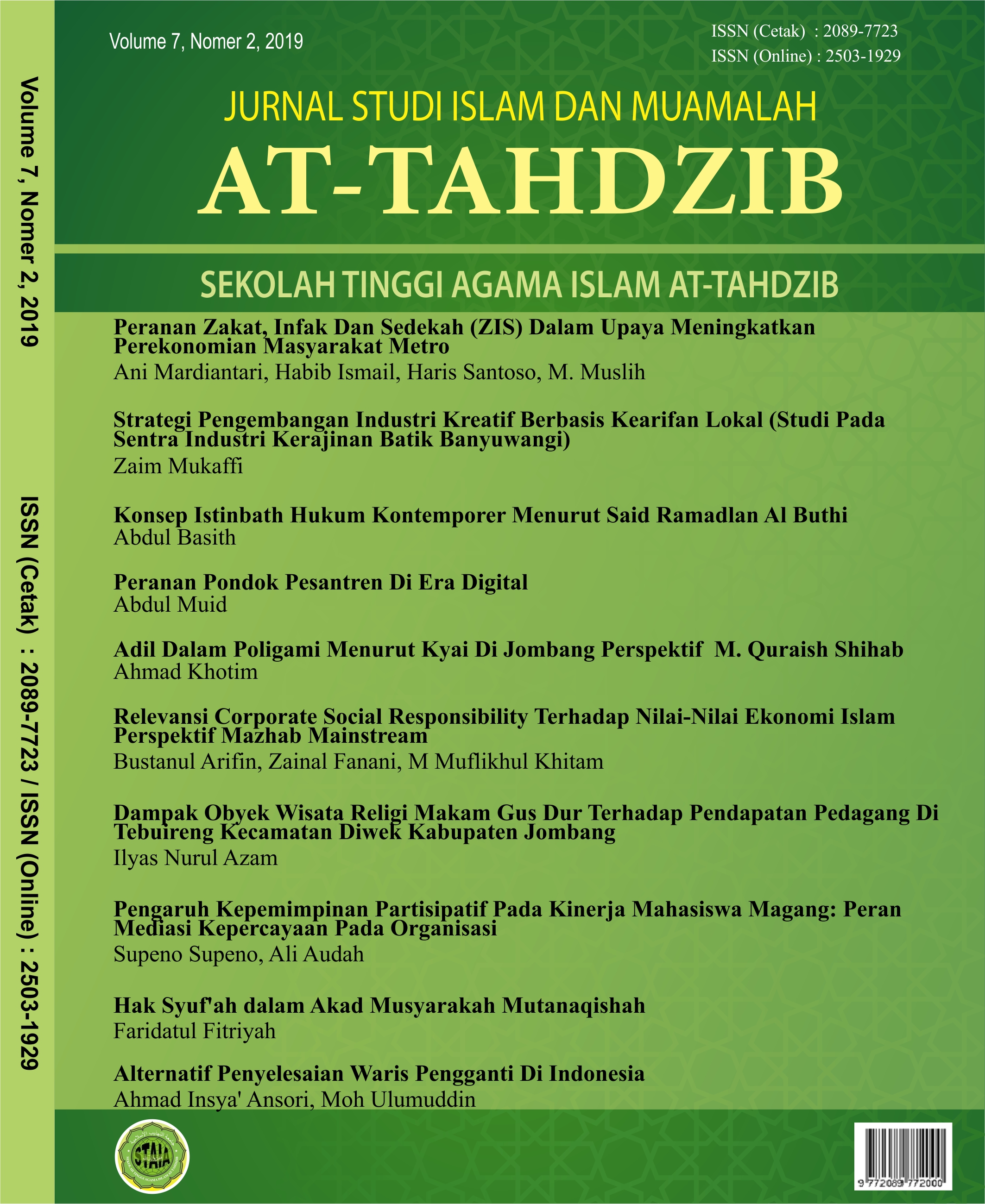Strategi Pengembangan Industri Kreatif Berbasis Kearifan Lokal (Studi Pada Sentra Industri Kerajinan Batik Banyuwangi)
Abstrak
The results of this study are 1) The value chain in the Banyuwangi batik craft industry is creation, production, distribution and commercialization. The four value chains are business processes that exist in the Banyuwangi batik craft industry.
2) The SWOT analysis technique shows the position index on internal factor analysis of + 0.796 and on the external position index of +0.8859. So that in the SWOT diagram that is seen in the position located on Quadrant I namely quadrant which means that the potential of the banyuwangi batik craft industry has a very large opportunity to grow and even compete with other batik industries. In addition, from the internal aspect shows that the ideas / ideas and creations that are built through the characteristics of Banyuwangi batik are very good.
3) To get optimal results in the development of creative industries in the Banyuwangi batik craft industry, collaboration between the main actors is needed with the starting points of these three main actors; (1) Commitment of intellectuals, business and government, continuous coordination between the three actors, and seek synergy to develop the creative industry. Where the role of the Banyuwangi district government has been to socialize about Banyuwangi batik to the outside public, both directly and through official media of the local government, besides training members, holding festivals both in Banyuwangi and outside. Whereas in terms of the role of academics, so far they have not contributed to the development of batik in Banyuwangi in the form of training, research results and community service. And from the aspect of the business actor, has carried out various methods with creative batik products according to their identity. The real form that is done is by using social media, opening cooperation with agents and opening their own outlets to introduce and sell their products.
Referensi
David, Fred R. Strategic Management, Philippines: Prentice Hall, 1998
Howkins, John (2001). The Creative Economy: How People Make Money From Idias. London. Plugin.
Jumiharni, Nila, 2013. Analisis SWOT PT. Pertamina (Persero). http://nilajumiharni.blogspot.co.id/2014/04.
Kadiman, Kusmayanto, 2006. Shaping A/B/G Innovation: Some Management Issues. Presentasi pada Penutupan MRC Doctoral Jorney Management Pertama. Jakarta: MRC FEUI Meeting
Kementerian Pariwisata dan Ekonomi Kreatif RI 2014. Ekonomi Kreatif: Kekuatan Baru Menuju 2025. www.kemenpar.go.id
Kementerian Perdagangan RI dalam buku Rencana Pengembangan Ekonomi Kreatif Indonesia 2009-2015. www.kemendag.go.id
Khristianto, Wheny. 2008. Peluang dan Tantangan Industri Kreatif di Indonesia. Jurnal Bisnis dan Manajemen, Vol. 5 No.1 Sep. 2008
Lemhanas RI. 2012. Pengembangan Ekonomi Kreatif Guna Menciptakan Lapangan Kerja dan Mengentaskan Kemiskinan dalam Rangka Ketahanan Nasional. Jurnal Kajian Lemhanas RI. Edisi14 Desember 2012.
Moelyono, Mauled. 2010. Menggerakkan Ekonomi Kreatif antara Tuntunan dan Kebutuhan. Jakarta: Raja Grafindo Persada
Primorac, Jaka. (2006). The position of cultural workers in creative industries: the south-eastern European perspective. European Cultural Foundation.
Perancangan Industri Kreatif Bidang Fashion dengan Pendekatan Benchmarking pada Queensland’s Creative Industry Mohammad Adam Jerusalem Jurusan PTBB-Fakultas Teknik-UNY adam_jerusalem@uny.ac.id Prosiding Seminar Nasional Program Studi Teknik Busana 2009 .
Pusparini dan Chafrani. 2010. Pengembangan Ekonomi Kreatif Berbasis Kearifan Lokal oleh Pemuda dalam Rangka Menjawab Tantangan Ekonomi Global. Jurnal UI untuk Bangsa Seri Sosial Humaniora. Volume 1, Desember 2010 Halaman 18.
Pusparini, Hesti. Strategi Pengembangan Industri Kreatif di Sumatera Barat (Studi Kasus Industri Kreatif Subsektor Kerajinan Industri Bordir/Sulaman dan Pertenunan. Jurnal online. www.andalas.ac.id.
Rangkuti, Freddy, 2009, Analisis SWOT Teknik Membedah Kasus Bisnis. Edisi Keenam Belas, PT. Gramedia Pustaka Utama, Jakarta
Satria, Dias & Prameswari, Ayu. 2011. Strategi Pengembangan Industri kreatif untuk meningkatkan Daya Saing Pelaku Ekonomi Lokal. Jurnal Aplikasi Manajemen. Volume 9. Nomor 1, Januari 2011. ISSN: 1693-5241.
Sidiq Mahfudz., Dkk. ibM Kelompok Pengrajin Keramik di Sentra Industri Keramik Dinoyo Kota Malang. Laporan Akhir Pengabdian Program IPTEK Bagi Masyarakat. LPM Unibraw. www.lppm.ub.ac.id
Stoner, James A. F., Alih Bahasa Alexander Sindoro, Penyunting Bambang Sayala, 1996, Manajemen. Edisi Keenam, Jilid I, Prehalindo, Jakarta.
Sugiyono, 2005. Memahami Penelitian Kualitatif, Alfabeta, Bandung.
Sumodiningrat, Gunawan. 2002. Ekonomika: Pengantar. Edisi 2003/2004. BPFE Universitas Gadjah Mada, Yogyakarta.
Suryana. 2013. Ekonomi Kreatif (Ekonomi Baru: Mengubah Ide dan Menciptakan Peluang. Salemba Jakarta.
Suwarjono, Muhammad, 2000. Manajemen Strategik Konsep dan Kasus, YKPN, Yogyakarta.
Tambunan, Tulus. 2003. Perekonomian Indonesia. Bogor: Ghalia Indonesia
Tjipto, Fandy. 1997. Strategi Pemasaran. Andi Yogyakarta.
UNCTAD. (2008). Creative Economy Report 2008. Hal. 3, 11-12. USA. United Nations
www.bekraf.go.id/Infografis Ringkasan Data Statistik Ekonomi Kreatif Indonesia
http://regional.kompas.com/read/2016/10/11/07020511/banyuwangi.jadi.percontohan.industri.kreatif.berbasis.desa
##submission.copyrightStatement##
##submission.license.cc.by4.footer##
Jurnal Studi Islam by At-Tahdzib is licensed under a Creative Commons Attribution 4.0 International License.
Based on a work at http://ejournal.kopertais4.or.id/index.php/tahdzib/index





